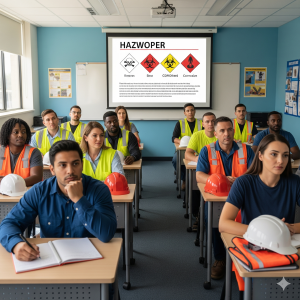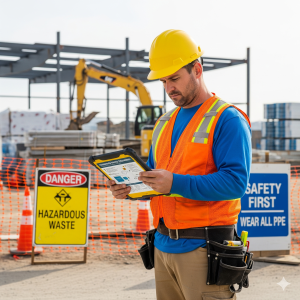A Guide to Hazwoper Training in Construction

The construction industry, known for its dynamic and sometimes hazardous environments, requires stringent safety protocols to protect workers and the public. Among these protocols, Hazardous Waste Operations and Emergency Response (Hazwoper) training stands out as a critical component. It is especially vital for projects involving hazardous materials. This comprehensive guide aims to educate construction workers, site safety and health officers, and superintendents on the importance of Hazwoper training. It highlights the mandatory nature of the Hazwoper 40-hour course and its benefits for ensuring a safer workplace.
Introduction to Hazwoper in Construction
In construction, the presence of hazardous materials is not uncommon. From asbestos in old buildings to chemical spills on new projects, these materials pose significant risks. Hazwoper standards are designed to equip workers with the knowledge and skills to manage these hazards safely. Understanding and implementing these standards are crucial steps toward fostering a safer construction environment. Risks must not only be managed but also anticipated and prevented.
Why Hazwoper Training is Mandatory
The Occupational Safety and Health Administration (OSHA) mandates Hazwoper training for a good reason
. Exposure to hazardous materials can lead to severe health issues, environmental harm, and legal consequences. This training ensures that workers can identify, handle, and respond to dangerous situations effectively. It minimizes risks while protecting both worker health and the environment. It’s not just about compliance. It is also about a commitment to safety.
Key Components of the Hazwoper 40-hour Course
The Hazwoper 40-hour course is comprehensive. It covers topics such as personal protective equipment, emergency response, and decontamination procedures. The course also explains the nature of hazardous substa
nces. Workers learn to recognize hazards and follow proper protocols for handling and disposal. This training is crucial for anyone involved in cleanup operations, emergency response, or handling hazardous materials. It provides them with the skills needed to maintain safety on construction sites.
Implementing Hazwoper Practices on Your Site
Adopting Hazwoper practices is more than just training. It’s about integrating these practices into the daily operations of a construction site. This requires continuous training, regular safety drills, and a strong commitment to safety culture. It also means ensuring all workers have the proper personal protective equipment. They must fully understand the protocols for hazard communication and emergency response. By integrating these practices into daily operations, firms can establish an environment where safety is consistently prioritized.
Extending Hazwoper Training Beyond Compliance
Meeting legal requirements is only the first step. Hazwoper training also fosters a proactive safety culture within the construction industry. Continuous education and refresher courses keep workers up to date on the latest safety protocols. They also encourage a workplace attitude that prioritizes safety above all. This proactive approach enhances safety on construction sites and contributes to the overall well-being of the workforce.
The Economic and Social Benefits of Hazwoper Training
Investing in Hazwoper training offers tangible economic benefits. It reduces accident-related costs and improves operational efficiency. The training also delivers substantial social benefits. It enhances a firm’s reputation and demonstrates a commitment to safety and environmental responsibility. This builds trust with clients, the community, and the construction industry as a whole. It also showcases the firm’s dedication to the highest safety standards.
The Dangers of Hazardous Materials on Construction Sites
Hazardous materials on construction sites pose a wide range of risks. These include immediate health hazards and long-term environmental impacts. Understanding these dangers is essential for effective risk mitigation. It highlights the importance of Hazwoper training in preparing workers to face these challenges safely and competently.
Mitigating the Risks
Effective risk mitigation requires a comprehensive approach. It combines Hazwoper training with strict adherence to safety regulations and strong emergency response plans. This ensures workers are trained to handle hazardous materials safely. It also prepares them to respond effectively in emergencies.
Case Studies: Hazwoper Impact in the Field
Real-world case studies offer valuable insights into the effectiveness of Hazwoper. They show how training has prevented environmental disasters and improved hazardous material management. They also highlight how well-trained workers have responded to emergencies on construction sites. These examples demonstrate the tangible benefits of Hazwoper training. It enhances both safety and compliance across the industry.
Conclusion: Embracing Hazwoper for a Safer Future
The Hazwoper 40-hour course is more than a regulatory requirement. It is an investment in the safety and well-being of construction workers and the public. By embracing Hazwoper training, professionals can mitigate risks associated with hazardous materials. They also contribute to a stronger safety culture and improve their firm’s reputation. As the industry evolves, Hazwoper training remains essential. It promotes best practices for safety and emergency response.
This commitment to safety protects workers and the environment. It also positions a firm as a leader in safety and health management. The construction industry continues to evolve, and Hazwoper training evolves with it. It equips workers with the knowledge and skills to face hazardous challenges. By prioritizing Hazwoper training, construction firms can build not just structures but also a legacy of safety and responsibility.
In conclusion, Hazwoper training is essential for ensuring construction safety. Its benefits extend beyond compliance, truly safeguarding lives and the environment. As construction projects grow in complexity and scale, the importance of Hazwoper training becomes even clearer. It is not just about meeting requirements. It is about building a culture of safety that touches every aspect of construction work. By investing in Hazwoper training, professionals show their commitment to excellence. They ensure a safer future for everyone involved in the industry.

